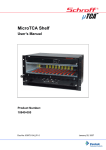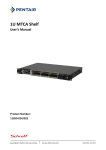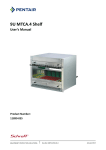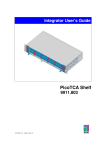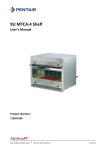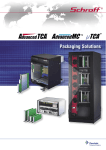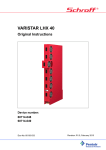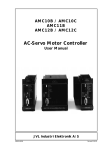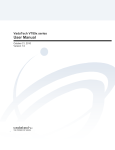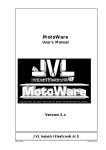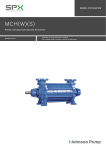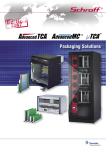Download for 11850-005/-007
Transcript
MicroTCA Development Systems User’s Manual Product Number: 11850-001 11850-002 11850-005 11850-007 Doc-No: 63972-175_R1.1 August 03, 2007 Rev. Date updated Change D1.0 October 04, 2006 Draft Release D1.1 December 04, 2006 Draft Release D1.1 R1.0 December 07, 2006 Initial Release R1.1 August 02, 2007 Backplane Topology 23005-419 changed Impressum: Schroff GmbH D-75334 Straubenhardt, Germany The details in this manual have been carefully compiled and checked - supported by certified Quality Management System to EN ISO 9001/2000 The company cannot accept any liability for errors or misprints. The company reserves the right to amendments of technical specifications due to further development and improvement of products. Copyright © 2006 All rights and technical modifications reserved. Schroff MicroTCA Development System 11850-001/-002/-005/-007 1 2 3 4 Safety ................................................................................................................. 1 1.1 Safety Symbols used in this document................................................................ 1 1.2 General Safety Precautions................................................................................. 1 1.3 References and Architecture Specifications ........................................................ 2 1.4 Product Definition ................................................................................................ 2 1.5 Terms and Acronyms........................................................................................... 3 Hardware Platform............................................................................................ 7 2.1 Front View............................................................................................................ 8 2.2 ESD Wrist Strap Terminal.................................................................................... 8 Backplane 23005-408 (for 11850-001/-002) ..................................................... 9 3.1 Backplane Topology ............................................................................................ 9 3.2 Fabric Interface.................................................................................................. 10 3.3 3.2.1 Common Options ................................................................................. 10 3.2.2 Fat Pipe ............................................................................................... 10 Synchronization Clock Interface ........................................................................ 10 3.4 Intelligent Platform Management Bus (IPMB).................................................... 10 3.5 3.4.1 IPMB-L ................................................................................................. 10 3.4.2 IPMB-0 ................................................................................................. 10 JTAG.................................................................................................................. 10 Backplane 23005-419 (for 11850-005/-007) ................................................... 11 4.1 Backplane Topology .......................................................................................... 11 4.2 Fabric Interface.................................................................................................. 12 4.3 4.2.1 Common Options ................................................................................. 4.2.2 Fat Pipe ............................................................................................... 4.2.3 Extended Fat Pipe ............................................................................... Synchronization Clock Interface ........................................................................ 4.4 Intelligent Platform Management Bus (IPMB).................................................... 12 4.5 4.4.1 IPMB-L ................................................................................................. 12 4.4.2 IPMB-0 ................................................................................................. 12 JTAG.................................................................................................................. 13 4.6 Carrier FRU SEEPROM .................................................................................... 13 4.7 Carrier Number .................................................................................................. 13 4.7.1 4.7.2 5 6 12 12 12 12 Mechanical DIP Switch ........................................................................ 13 Electronic DIP Switch........................................................................... 14 Power Unit ....................................................................................................... 15 5.1 5.0.1 DC Connection Cable .......................................................................... 16 Power Supplies.................................................................................................. 17 5.2 Power Feedthrough Module (PFM) ................................................................... 18 Cooling Unit .................................................................................................... 21 www.a-tca.com / www.schroff.biz I R1.1, August 03, 2007 Schroff MicroTCA Development System 11850-001/-002/-005/-007 7 6.1 Air Filter ............................................................................................................. 21 6.2 Introduction ........................................................................................................ 21 6.3 Air Filter Replacement ....................................................................................... 21 6.4 Air Filter Presence Sensor................................................................................. 21 6.5 Fan Tray ............................................................................................................ 22 Technical Data ................................................................................................ 23 7.1 Part Numbers..................................................................................................... 23 www.a-tca.com / www.schroff.biz II R1.1, August 03, 2007 Schroff MicroTCA Development System Safety 11850-001/-002/-005/-007 1 Safety The intended audience of this User’s Manual is system integrators and hardware/ software engineers. 1.1 Safety Symbols used in this document Hazardous voltage! This is the electrical hazard symbol. It indicates that there are dangerous voltages inside the Shelf. Caution! This is the user caution symbol. It indicates a condition where damage of the equipment or injury of the service personnel could occur. To reduce the risk of damage or injury, follow all steps or procedures as instructed. Danger of electrostatic discharge! The Shelf contains static sensitive devices. To prevent static damage you must wear an ESD wrist strap. 1.2 General Safety Precautions Warning! Voltages over 60 VDC can be present in this equipment. This equipment is intended to be accessed, to be installed and maintained by qualified and trained service personnel only. • Service personnel must know the necessary electrical safety, wiring and connection practices for installing this equipment in a telecommunication environment. • Install this equipment only in compliance with local and national electrical codes. • For additional information about this equipment, see the PICMG MicroTCA Specification (www.picmg.com). www.a-tca.com / www.schroff.biz 1 R1.1, August 03, 2007 Schroff MicroTCA Development System Safety 11850-001/-002/-005/-007 1.3 References and Architecture Specifications • PICMG® MicroTCA® Base Specification (www.picmg.com) • PICMG® AMC® Base Specification (www.picmg.com) 1.4 Product Definition The Schroff 11850-001/-002 are MicroTCA development systems. • 11850-001: 12+2+2 slot 8 U System for AMC double modules • 11850-002: 12+2+2 slot 8 U System for AMC single modules • 11850-005: 9+2+2 slot 6 U System for AMC single modules • 11850-007: 9+2+2 slot 8 U System for AMC double modules www.a-tca.com / www.schroff.biz 2 R1.1, August 03, 2007 Schroff MicroTCA Development System Safety 11850-001/-002/-005/-007 1.5 Terms and Acronyms Table 1: Terms and Acronyms AMC Advanced Mezzanine Card. AMC defines a modular card that extends the functionality of a Carrier board. Often referred to as mezzanines, these cards called also „AMC Modules. Backplane An interconnecting device with connectors, allowing Modules to plug into it Board An electronic assembly usually consisting of components mounted on a printed circuit Card Guide A mechanical component that provides for the AdvancedMC guidance feature in a Slot Carrier Local Address The combination of Site Type and Site Number that uniquely identify a Module within a MicroTCA Carrier Carrier Manager A logical function that manages and controls the AdvancedMC Modules, OEM Modules, PMs, and CUs in a MicroTCA Carrier through a set of signals controlled by the PMs together with the IPMB links Carrier Number A value to uniquely identify a MicroTCA Carrier within a Shelf Channel A group of up to four Ports in the Fat Pipes region which are logically grouped together via E-Keying to define the physical traces of a Link between Link partners. Multiple Channels can be aggregated for a wider Link. Channel ID An index into the list of AMC Channels that are defined on an MCH or on a Module CO Central Office Common Options Region The low order portion of the AdvancedMC Lane mappings, where Lanes are defined as common control fabric interfaces. MicroTCA uses these as a basic interconnect between the AdvancedMCs and MCHs. Contact List Defines the use of each contact. Directed signals appear in the lists differently, as applicable to the respective viewpoint of the Module and the MicroTCA Backplane. Cooling Unit (CU) A subassembly including fans or blowers to move air to cool a MicroTCA Shelf and related support electronics CU See Cooling Unit Cube A MicroTCA packaging option where AdvancedMCs, MCHs, PMs, cooling, and mechanical elements are all packaged in a small, roughly cubic enclosure that is approximately 200 mm or 8 in. on a side Double-Width Slot Mounting location on a MicroTCA Shelf for a Full-Height or Half-Height Double-Width Module. Double-Width Slots may be created by removing a Strut and Card Guide between two Single-Width Slots. Double-Width Mod- A Module that is roughly twice the width of a Single-Width AdvancedMC Module. Douule ble-Width AdvancedMCs measure approximately 150 mm wide. EIA Electronic Industry Association Electronic Keying or E-Keying Abbreviation for Electronic Keying. Electronic Keying defines the process in which a MicroTCA Shelf determines if the Control and Fabric interfaces on a Module are compatible with the MicroTCA Shelf interconnects and the other Modules they reach. EMC Electromagnetic Compatibility is the condition that prevails when telecommunications (communication-electronic) equipment is collectively performing its individual designed functions in a common electromagnetic environment without causing or suffering unacceptable degradation due to electromagnetic interference to or from other equipment/ systems in the same environment. EMC Gasket An electrically conductive elastic stripe mounted to defined edges of the Face Plate providing EMC closure around the AdvancedMC Slots EMMC Enhanced Module Management Controller, used on Cooling Units, Power Module, and OEM Modules. See Module Management Controller (MMC). ESD Electrostatic Discharge ETSI European Telecommunications Standards Institute Extended Region The high order portion of the AdvancedMC Lane mappings that are typically used to carry special or high speed data streams. MicroTCA uses the Extended Region to provide high bandwidth interconnects beyond what can be carried on the Common Options Region or Fat Pipes region. Fabric Interface The set of MCH Fabric Channel interfaces that provides up to seven Fabric Channels to the AdvancedMCs www.a-tca.com / www.schroff.biz 3 R1.1, August 03, 2007 Schroff MicroTCA Development System Safety 11850-001/-002/-005/-007 Fabric, Fabric Channel The connection where the MCH is the endpoint of a Slot-to-Slot connection to one-to four Ports on an AdvancedMC Face Plate The front-most element of a Module, attached perpendicular to the PCB, which serves to mount Connectors, indicators, controls, and also seals the front of the Subrack for airflow and EMC Fat Pipe A data transmission circuit or network that is capable of carrying large amounts of data without significantly degrading the speed of transmission. The term is derived from the simple plumbing fact that a larger diameter pipe will carry more fluid (or gas) at a greater rate than a smaller one. MicroTCA uses Fat Pipes as high bandwidth interconnects to supplement the Common Options Region. Frame An enclosure used for mounting one or more MicroTCA Shelves FRU Field Replaceable Unit, any entity that can be replaced by a user in the field FRU Device ID A value that uniquely identifies a FRU relative to an IPM Controller. In MicroTCA the most frequent use of FRU Device ID is to uniquely identify a FRU within a MicroTCA Carrier relative to the Carrier Manager. FRU Information Data that describes a FRU with an emphasis on data that characterizes the FRU. Format for this data is described in IPMI Platform Management FRU Information Storage Definition and extended herein. Full-Height Module Modules that have a Full-Height Face Plate and allow for taller components on Component Side 1 of the Module. Face Plate height is 28.95 mm. GbE Gigabit Ethernet (1000BASE-BX) Gbps Gigabits (= 1,000,000,000 bits) per second GBps Gigabytes (= 1,000,000,000 bytes) per second Geographic Address (GA) Identifies the Site Number part of the Carrier Local Address of a Slot in a MicroTCA Carrier via three, three-state signals. Each valid GA combination of the three signals maps to a specific Slot in a MicroTCA Carrier. HA High Availability Half-Height Module The component height on Component Side 1 of Half-Height Modules is optimized to allow for two stacked Modules to equally split the maximum height (AdvancedTCA pitch) available. The term Half-Height should not be taken literally as being half of a Full-Height Module. Face Plate height is 13.88 mm. Hot Swap To remove a component (e.g., an AdvancedMC Module) from a system (e.g., an MicroTCA Shelf) and plug in a new one while the power is still on and the system is still operating Hot Swap Switch A switch that is integrated with the Module Latch Mechanism so that its state reflects the state of the Latch. The Hot Swap Switch is disconnected when the Module Handle is fully inserted. HP Horizontal Pitch. A measure of Module-to-Module spacing equaling 0.2 in. Intelligent FRU A FRU containing a management controller. Intelligent FRUs include the AdvancedMCs, MCHs, CUs, PMs, and OEM Modules, etc. IPMB Intelligent Platform Management Bus. The lowest level hardware management bus as described in the Intelligent Platform Management Bus Communications Protocol Specification. IPMB-0 A dual redundant IPMB that connects MCMCs and EMMCs in a MicroTCA Carrier. Electrically and logically separate from the Local IPMB (IPMB-L). IPMB-A, IPMB-B Intelligent Platform Management Buses A and B, respectively. Refers to the two redundant IPMBs that aggregate into IPMB-0. IPMB-L or Local IPMB Connects AdvancedMC’s MMC with the MCH’s MCMC. Electrically and logically separate from the MCMC’s IPMB-0. IPMI Intelligent Platform Management Interface. A specification and mechanism for providing inventory management, monitoring, logging, and control for elements of a computer system as defined in Intelligent Platform Management Interface Specification. JTAG Formally, Joint Test Action Group, an organization that proposed adoption of a specification for a test access port and boundary-scan architecture. Informally, but commonly, the standard, namely IEEE Std 1149.1, that arose from the efforts of the Joint Test Action Group. JTAG Switch Mod- A Module that controls the distribution of JTAG signaling to the AdvancedMCs and ule (JSM) MCHs within a MicroTCA Carrier www.a-tca.com / www.schroff.biz 4 R1.1, August 03, 2007 Schroff MicroTCA Development System Safety 11850-001/-002/-005/-007 Keying Block Mechanical entity installed on the backplane used to allow full insertion of Modules that comply with specific mating requirements related to optional Auxiliary Connectors and prevent full insertion of Modules that don't comply Lane 1. A set of differential signal pairs, one pair for transmission and one pair for reception. One or more Lanes operate together to form a Link 2. E-Keying definition of a differential pair associated with a specific Fabric Link (e.g., a Link generally consists of Lanes[x:0]) Ground, or GND The reference potential for logic signaling and local power distribution on the MicroTCA Shelf and on the Module MAC Media Access Control Managed FRU Either an Intelligent FRU or a FRU that is represented by an Intelligent FRU via a FRU Device ID Management Power (MP) The 3.3 V power for a Module's management function, individually provided to each Slot by the MicroTCA Shelf Management Power Channel An independently managed electrical path that carries Management Power to a Module from a bulk power source MCH See MicroTCA Carrier Hub MCH Crossover Channel An interface between two MCHs used for implementation-defined communication MCH Update Channel An interface between two MCHs used to synchronize state information MCMC See MicroTCA Carrier Management Controller MicroTCA This specification, governing the application of AdvancedMCs directly on a Backplane. Although not preferred, it is also acceptable to abbreviate it uTCA or ÏTCA. MicroTCA Carrier A group of functions conforming to AMC.0 required to properly support up to twelve AdvancedMC Modules connected together via a common Backplane. The MicroTCA Carrier functions include: power regulation and distribution, hardware platform management, fabric connectivity and optionally clock distribution and JTAG test control. MicroTCA Carrier Hub (MCH) An assembly providing MicroTCA Carrier functions needed to support up to twelve AdvancedMCs including MCMC, optional ShMC, optional Fabric switch, and clock. MicroTCA Carrier Management controller on the MCH. The required management controller that interManagement Con- faces to AdvancedMC MMCs via IPMB-L and to CU, PM, and OEM Module EMMCs via IPMB-0. troller (MCMC) MMC The required management controller on an AdvancedMC Module which interfaces to the MicroTCA Carrier Manager on the MCH via IPMB-L Module Refers to any MicroTCA Module types, including CU, PM, MCH, OEM Module, or AdvancedMC Module EMC Gas- Compressible woven EMC material along the left hand side and the bottom of the Modket ule Module Handle Hand grip that is connected to the Module Latch Mechanism, provides user interface that initiates Hot Swap sequence and Module removal Module Latch Mechanism Mechanism to hold the Module locked in the Slot with the Module in contact with the bottom of the Slot. The Module Latch Mechanism also provides coupling to the Hot Swap Switch. Module LEDs The collective name for the following LEDs available at the Module Face Plate: BLUE LED, LED 1, LED 2, LED 3 MP See Management Power MTBF Mean Time Between Failure(s) NEBS Network Equipment Building Systems. A specification published by Telecordia governing the environmental characteristics of telecommunications equipment. Payload The primary function that a FRU provides. This includes all the hardware on the FRU except that associated with management. It may also include the firmware, operating system and application software running on the Payload hardware. Payload Interface The interface, usually local to the Module, between an (E)MMC and its Payload Payload Power The nominal 12 V supply power, individually provided to each Slot by the MicroTCA Shelf for the payload function of the Module Payload Power Channel An independently managed electrical path that carries Payload Power to a Module from a bulk power source www.a-tca.com / www.schroff.biz 5 R1.1, August 03, 2007 Schroff MicroTCA Development System Safety 11850-001/-002/-005/-007 PICMGÆ PCI Industrial Computer Manufacturers Group (PICMG). An industry standards body responsible for the creation of specifications such as AdvancedTCA, AdvancedMC, and MicroTCA. PM See Power Module Port A set of differential signal pairs, one pair for transmission and one pair for reception Power Channel A FRU connection to the Power Subsystem, consisting of Payload Power, Management Power, ENABLE# and PS1# Power Module (PM) Front accessible Module that controls the power entry, conversion and distribution of 12 V Payload Power to the Modules within a MicroTCA Shelf Power Module Input Connector The connector on the PM Face Plate to which input power is connected Power Module OutThe PM connector that mates with the backplane connector put Connector Power Subsystem The PMs operating together in a MicroTCA Carrier Primary PM The PM that provides primary power for a given power channel PWR See Payload Power Redundant PM A PM that takes over for any failed Primary PM RoHS Restriction of the Use of Certain Hazardous Substances Sensor Data Record (SDR) A data structure record that describes the properties of a sensor, management controller or FRU Information device. Defined in IPMI. Shelf An electronic assembly consisting of the Subrack, Backplane, Modules, cooling devices, power subsystems, etc. Also historically known as a chassis. Shelves are usually mounted in Frames. Shelf-Carrier ManA logical IPMB between the Shelf Manager and the Carrier Managers ager Interface Shelf Ground The electrical potential of the metal Frame of the system, the Face Plate of the MicroTCA Shelf, and the Face Plate of the Module. It is important for electrical safety. Shelf Manager The entity responsible for managing the cooling in a MicroTCA Shelf. It also routes messages between the System Manager Interface and the Shelf-Carrier Manager Interface, provides interfaces to system repositories, and responds to event messages. Single-Width Mod- AdvancedMC Module with a width around 74 mm which fits in a Single-Width ule AdvancedMC Slot Slot The union of a Connector and a Card Guide that defines the position of one AdvancedMC, MCH, Power Module, OEM Module or CU. Slots are similar in concept to the Bays used in the AMC.0 specification. A MicroTCA Subrack typically contains multiple Slots. Slot Number Uniquely identifies a Slot within a Shelf Startup PM A Power Module selected by the Power Subsystem during power up, to operate in autonomous mode and automatically provide Management Power, asserts ENABLE#, and provide Payload Power to CU and conditionally to MCH Power Channels that are present. Subrack A mechanical assembly that provides the interface to Modules, including AdvancedMCs, and consists of the Card Guides, ESD discharge, alignment/keying, Handle interface, Face Plate mounting hardware, EMC Gasketing, and Backplane interface System Event Log (SEL) Persistent Storage for events as defined by IPMI System Manager A level of management functionality above the Shelf Manager charged with the management of an entire system, whatever that may mean in a specific implementation System Manager Interface The communication interface between Shelf Manager and System Manager Tier A horizontal row of Modules across a Shelf Zone 3 A region used for I/O expansion typically above an AdvancedMC Connector within a Slot (standard vertical orientation, viewed from the front) www.a-tca.com / www.schroff.biz 6 R1.1, August 03, 2007 Schroff MicroTCA Development System Hardware Platform 11850-001/-002/-005/-007 2 Hardware Platform The Schroff MicroTCA development systems implement the following features: • Compliant to PICMG MicroTCA Base specification • ratiopacPRO case with front handles (19” rack mounting brackets optional) • MicroTCA Backplane with radial IPMI from both MCH slots to all AMC and PM slots, supporting: - 11850-001 - 8 AMC Full-size Double slots - 4 AMC Compact Double slots - 2 redundant MicroTCA Carrier Hub (MCH) slots (Full-size Double) - 2 Power Module (PM) slots (9 HP Double) - 11850-002 - 8 AMC Full-size Single slots - 4 AMC Compact Single slots - 2 redundant MicroTCA Carrier Hub (MCH) slots (Full-size Single) - 2 Power Module (PM) slots (9 HP Single) - 11850-005 - 9 AMC Full-size Single slots - 2 redundant MicroTCA Carrier Hub (MCH) slots (Full-size Single) - 2 Power Module (PM) slots (9 HP Single) - 11850-007 - 9 AMC Full-size Double slots - 2 redundant MicroTCA Carrier Hub (MCH) slots (Full-size Double) - 2 Power Module (PM) slots (9 HP Double) • Active cooling through a hot-swappable Cooling Unit (CU) providing 3 temperature controlled 12 VDC fans. • Front accessible air inlet filter • Power unit with 4 DC outputs and 2 slots for 1 U Power supplies (power supplies optional) • Power Feedthrough Modules (optional) www.a-tca.com / www.schroff.biz 7 R1.1, August 03, 2007 Schroff MicroTCA Development System Hardware Platform 11850-001/-002/-005/-007 2.1 Front View Figure 1: Front View (11850-001) 1 MicroTCA Backplane 6 Power Supply 1 (optional) 2 Cable Tray 7 Fan Tray 3 Air Filter 8 DC Outputs Power Supply 1 4 DC Outputs Power Supply 1 9 ESD Wrist Strap Terminal 5 Grounding Terminals 10 Slot for Power Supply 2 2.2 ESD Wrist Strap Terminal Danger of electrostatic discharge! Static electricity can harm delicate components. You must wear an ESD wrist strap before exchanging any part or electric component! The ESD Wrist Strap Terminal (4 mm banana jack) is located at the lower front side of the Shelf. www.a-tca.com / www.schroff.biz 8 R1.1, August 03, 2007 Schroff MicroTCA Development System Backplane 23005-408 (for 11850-001/-002) 11850-001/-002/-005/-007 3 Backplane 23005-408 (for 11850-001/-002) The 12+2+2 slot MicroTCA Backplane provides: • 8 AMC Full-size slots (6 HP) • 4 AMC Compact slots (3 HP) • 2 MicroTCA Carrier Hub (MCH) slots (6 HP) • 2 Power Module (PM) slots (9 HP) • 1 Connector for Fan Tray 3.1 Backplane Topology Figure 2: Backplane Topology MCH1 Fabric [A] to AMC Port 0 MCH2 Fabric [A] to AMC Port 1 AMC Port 2 AMC Port 3 Fat Pipe AMC Ports [4:7] to AMC Ports [4:7] 4 4 4 MCH1 Ports [D:G] to AMC Ports [4:7] 4 4 4 4 4 4 Clocks MCH2 CLK1 to AMC CLK1 Clocks MCH1 CLK1 to AMC CLK3 AMC CLK3 to AMC CLK3 AMC2# AMC3# AMC4# AMC8# AMC1# AMC7# MCH1# AMC6# PM1# Bi-direct. Clocks AMC CLK2 to MCH2 CLK2 AMC5# Bi-direct. Clocks AMC CLK2 to MCH1 CLK2 AMC9# AMC10# AMC11# AMC12# MCH2# PM2# 12806809 www.a-tca.com / www.schroff.biz 9 R1.1, August 03, 2007 Schroff MicroTCA Development System Backplane 23005-408 (for 11850-001/-002) 11850-001/-002/-005/-007 3.2 Fabric Interface 3.2.1 Common Options MCH1 Fabric Port A is routed to all AMC slots Port 0 in a radial configuration. MCH2 Fabric Port A is routed to all AMC slots Port 1 in a radial configuration. AMC Ports 2 and 3 are direct slot to slot connections to support CPU/HDD configurations. 3.2.2 Fat Pipe MCH1 Ports [D:G] are routed to Ports [4:7] at AMC slots [2,3,5,7,9,11] in a radial configuration. There are also direct AMC slot to AMC slot connections. (See Backplane Topology). 3.3 Synchronization Clock Interface Clock 1 from MCH2 is routed to Clock 1 on each AdvancedMC. Clock 1 on MCH1 is routed to Clock 3 on several AdvancedMC. There are also direct AMC slot to AMC slot connections. (See Backplane Topology). Clock 2 is the line recovered clock from the AdvancedMC to both MCHs. 3.4 Intelligent Platform Management Bus (IPMB) MicroTCA uses an Intelligent Platform Management Bus (IPMB) for management communications. 3.4.1 IPMB-L The IPMB among AdvancedMCs and the MCHs is non-redundant and implemented in a radial topology. This IPMB called Local IPMB (IPMP-L) 3.4.2 IPMB-0 The IPMB among the MCH, the PM and the CU is called IPMB-0. The reliability of the IPMB-0 is improved by the addition of a second IPMB, with the two IPMBs referenced as IPMB-A and IPMB-B. The IPMB-A and IPMB-B are routed in a bused configuration. IPMB-A and IPMB-B are electrically and logically separate from the Local IPMB (IPMB-L) 3.5 JTAG JTAG signals are not supported. www.a-tca.com / www.schroff.biz 10 R1.1, August 03, 2007 Schroff MicroTCA Development System Backplane 23005-419 (for 11850-005/-007) 11850-001/-002/-005/-007 4 Backplane 23005-419 (for 11850-005/-007) The 9+2+2 slot MicroTCA Backplane provides: • 9 AMC full size slots (6 HP) • 2 MicroTCA Carrier Hub (MCH) slots (6 HP) • 2 Power Module (PM) slots (9 HP) • 1 Connector for Fan Tray 4.1 Backplane Topology Figure 3: Backplane Topology MCH1 Fabric [A] to AMC Port 0 MCH2 Fabric [A] to AMC Port 1 AMC Port 2 AMC Port 3 Fat Pipe MCH1 Ports [D:G] to AMC Ports [4:7] 4 4 4 4 4 4 4 4 4 4 4 4 4 4 4 4 4 4 Extend. Fat Pipe MCH2 Ports [D:G] to AMC Ports [8:11] Clocks MCH1 CLK1 to AMC CLK1 Clocks MCH2 CLK1 to AMC CLK3 Bi-direct. Clocks AMC CLK2 to MCH1 CLK2 PM1# MCH1# Bi-direct. Clocks AMC CLK2 to MCH2 CLK2 AMC1# (CPU) AMC2# (HDD) AMC3# (HDD) AMC4# (CPU) AMC5# AMC6# (CPU) AMC7# (HDD) AMC8# (HDD) AMC9# (CPU) MCH2# PM2# 12806805 www.a-tca.com / www.schroff.biz 11 R1.1, August 03, 2007 Schroff MicroTCA Development System Backplane 23005-419 (for 11850-005/-007) 11850-001/-002/-005/-007 4.2 Fabric Interface 4.2.1 Common Options MCH1 Fabric Port A is routed to all AMC slots Port 0 in a radial configuration. MCH2 Fabric Port A is routed to all AMC slots Port 1 in a radial configuration. AMC Ports 2 and 3 are direct slot to slot connections to support CPU/HDD configurations. 4.2.2 Fat Pipe MCH1 Ports [D:G] are routed to all AMC slots Port [4:7] in a radial configuration. 4.2.3 Extended Fat Pipe MCH2 Ports [D:G] are routed to all AMC slots Port [8:11] in a radial configuration. 4.3 Synchronization Clock Interface Reference clocks from each MCH are connected to each AdvancedMC, and a single clock from each AdvancedMC is routed to each MCH. Clock 1 from MCH1 is routed to Clock 1 on each AdvancedMC. Clock 1 on MCH2 is routed to Clock 3 on each AdvancedMC. This allows redundant clocks from the two MCHs to each AdvancedMC. Clock 2 is the line recovered clock from the AdvancedMC to both MCHs. 4.4 Intelligent Platform Management Bus (IPMB) MicroTCA uses an Intelligent Platform Management Bus (IPMB) for management communications. 4.4.1 IPMB-L The IPMB among AdvancedMCs and the MCHs is non-redundant and implemented in a radial topology. This IPMB called Local IPMB (IPMP-L) 4.4.2 IPMB-0 The IPMB among the MCH, the PM and the CU is called IPMB-0. The reliability of the IPMB-0 is improved by the addition of a second IPMB, with the two IPMBs referenced as IPMB-A and IPMB-B. The IPMB-A and IPMB-B are routed in a bused configuration. IPMB-A and IPMB-B are electrically and logically separate from the Local IPMB (IPMB-L) www.a-tca.com / www.schroff.biz 12 R1.1, August 03, 2007 Schroff MicroTCA Development System Backplane 23005-419 (for 11850-005/-007) 11850-001/-002/-005/-007 4.5 JTAG JTAG signals are not supported. 4.6 Carrier FRU SEEPROM Two SEEPROMS are located at the backside of the Backplane. The SEEPROMS are connected to both MCHs through I²C-busses. The I²C-addresses of the SEEPROMs is 0xa4. 4.7 Carrier Number Each MicroTCA Carrier shall have a unique Carrier Number, ranging from 1 to 16 in its MicroTCA Shelf. To provide the Carrier Number, a mechanical and electronic (PCA9558) DIP switch and a PCF8574A I²C I/O expander is located on the Backplane. Figure 4: Carrier Number Switches Mech. DIP-Switch GND Elec. DIP-Switch I/O Expander SW1 IN 0 OUT 0 P0 SW2 IN 1 OUT 1 P1 SW3 IN 2 OUT 2 P2 SW4 IN 3 OUT 3 P3 SW5 A0 SW6 MCH’s private I2C bus EEPROM 3.3 V 3.3 V SCL SDA SEL GND PCA9558 PCF8574A 12807826 The customer can use either the mechanical or the electronic DIP switch to set the carrier number. 4.7.1 Mechanical DIP Switch The mechanical DIP switch is a 6-position switch. • Switch 1 to 4 are used to set the carrier number (Switch 1 = Bit 0). • Switch 5 is used to change the I2C-address of the electronical DIP switch. - Switch 5 ON: address = 9C - Switch 5 OFF: address = 9E • With switch 6 you can select between mechanical or electronic DIP switch to set the carrier number. - Switch 6 ON: Mechanical DIP switch - Switch 6 OFF: Electronic DIP switch www.a-tca.com / www.schroff.biz 13 R1.1, August 03, 2007 Schroff MicroTCA Development System Backplane 23005-419 (for 11850-005/-007) 11850-001/-002/-005/-007 When setting the carrier number with the mechanical DIP switch please note: Switch ON = logic 0 Switch OFF = logic 1 The mechanical DIP switch is connected to the input of the electronic DIP switch. When the SEL signal is a logic 0, the electronic DIP switch will select the data from the internal EEPROM to drive the output pins, when the SEL signal is a logic 1, the electronic DIP switch will select the signal from the mechanical DIP switch to drive on the output pins. 4.7.2 Electronic DIP Switch The electronic DIP switch is connected to the lower four bits of the I/O lines of the PCF8574A I²C I/O expander. The I/O expander connects to the MCMC’s private I²C bus. The MCMC reads the DIP switch setting from the I/O expander, adds one, and uses the result as its Carrier Number. In the default factory setting the electronical DIP switch is active at the address 0x9E (SW5 and SW6 at the mechanical DIP switch = OFF) Default carrier address = 1 (Data content EEPROM = 0000) Table 2: I²C Addresses s PCA 9558 DIP switch 0x9e or 0x9c PCF8574A I/O expander 0x3e To change the carrier number with the electronic DIP switch you have to send the following I2C command to the electronic DIP switch’s EEPROM: 9 ACKNOWLEDGE C (A0 = 0) E (A0 = 1) ACKNOWLEDGE www.a-tca.com / www.schroff.biz ACKNOWLEDGE CARRIER NUMBER A ADDRESS PCA9558 ACKNOWLEDGE A COMMAND BYTE 1 EEPROM ADDRESS 14 DATA FOR EEPROM R1.1, August 03, 2007 Schroff MicroTCA Development System Power Unit 11850-001/-002/-005/-007 5 Power Unit In order to be independent from an external power source, the MicroTCA Development Systems provides a Power Unit at the bottom. The Power Unit provides 2 slots for pluggable 12 V or 48 V power supplies and 4 power outputs. The power outputs are female D-Sub 7W2 high power connectors. The voltage at the power connectors depends on the type of power supply plugged in. Contact A1 = (+) Contact A2 = (-) Warning! Verify the voltage and the polarity of the power outputs before connecting to a Power Feedthrough Module (PFM) or to a Power Module (PM). The PFM is designed to feedthrough a supply voltage of 12 VDC directly to the Backplane. Connecting a 48 VDC power supply to a PFM may destroy all AMC Modules! Figure 5: Power Unit 12806802 1 DC Output Power Supply 1 4 Power Supply 2 DC Output Power Supply 1 5 Mains Switch 3 Ground Terminal 6 IEC 320-C14 Connector www.a-tca.com / www.schroff.biz 15 R1.1, August 03, 2007 Schroff MicroTCA Development System Power Unit 11850-001/-002/-005/-007 5.0.1 DC Connection Cable The DC connection cables are not included with the Shelf. There are different connection cables available to connect the Power Feedthrough Module (PFM) or the Power Module (PM) to the Power Unit. For safety reasons the connectors of the Power Module (D-Sub 7W2) and the Power Feedthrough Module (D-Sub 3W3) are not identical. Figure 6: DC Connection Cable 12806810 Table 3: DC Connection Cable e Part Number L Connector A Connector B Description 23204-176 200 mm D-Sub 7W2, male D-Sub 3W3, female To connect the Power Unit to the Power Feedthrough Module (12 V to 12 V connection) 23204-182 500 mm D-Sub 7W2, male D-Sub 3W3, female To connect the Power Unit to the Power Feedthrough Module (12 V to 12 V connection) 23204-177 200 mm D-Sub 7W2, male D-Sub 7W2, female To connect the Power Unit to the Power Module (48 V to 48 V connection) Figure 7: Power Connector Pinout A3 A2 A1 D-Sub 3W3 female A2 A1 D-Sub 7W2 female A1 A2 D-Sub 7W2 male 12806811 The connectors are shown with the cables pointing away. Depending on the Power Supply and PM/PFM the pin assignment is: A1 = +12 V or RETURN A2 = GND or -48 VDC www.a-tca.com / www.schroff.biz 16 R1.1, August 03, 2007 Schroff MicroTCA Development System Power Unit 11850-001/-002/-005/-007 5.1 Power Supplies The high-efficient, pluggable power supplies providing a wide range 85 VAC - 264 VAC input. Passive current share along with internal ORing diodes allow the power supply to be used in redundant hot -swap applications. The power supplies are available with 12 V / 25 A output (11098-287) or 48 V / 6.25 A output (11098-288) Features: • Wide input voltage range 85-264 VAC • Low conducted and radiated EMI (EN 55022 class B) • UL recognized to UL 60950/CSA 22.2 No. 60950-00, and TUV approved to EN 60950-1 • High density design • 101.6 mm x 40.48 mm x 215.9 mm cassette • Highly-efficient topology • Overtemperature, output overvoltage and output overcurrent protection • Supervisory signaling • Included ORing diode for true redundant operation Table 4: Data AC Power Supply e 12 V power supply (11098-287) 48 V power supply (11098-288) Input voltage nominal 85 - 264 VAC 85 - 264 VAC Mains Frequency 50 / 60 Hz 50 / 60 Hz Output (max.) 25 A 6.25 A Output voltages 12 V DC 48 V DC Output voltage ripple and noise max. 120 mVpp max. 120 mVpp Recovery time to within 1% < 400 µsec < 400 µsec Overvoltage protection 115 – 130 % Vnom 115 – 130 % Vnom Overcurrent protection 110 – 130 % Inom 110 – 130 % Inom Operating Temperature 0° C - +55° C 0° C - +55° C Storage Temperature -40° C - +85° C -40° C - +85° C More detailed information in the Data Sheets included with the power supplies. www.a-tca.com / www.schroff.biz 17 R1.1, August 03, 2007 Schroff MicroTCA Development System Power Unit 11850-001/-002/-005/-007 5.2 Power Feedthrough Module (PFM) The Schroff 23098-561 is a 12 V / 40 A Power Feedthrough Module (PFM) that fits into the MicroTCA power module slot. The 12 V Power Feedthrough Module (PFM) is specially designed for the development system to support the backplane with 12 V power. The PFM provides: • Over-voltage protection • Reverse polarity protection • 3.3 V management power supply • Hot-swap functionality • 4 Status LEDs • Fused power outputs The PFM has a connector for the 12 V input voltage at the front panel. When the input voltage and polarity is in the specified range and the AMC handle closed, the PFM distributes the power to the AMC slots, the MCH slots and the Cooling Units (CUs). The PFM also generates the 3.3 V management power and distributes it to all slots. Caution! The power input is not fused. The maximum input current permitted is 40 A. Figure 8: Power Feedthrough Module (PFM) 12806800 www.a-tca.com / www.schroff.biz 18 R1.1, August 03, 2007 Schroff MicroTCA Development System Power Unit 11850-001/-002/-005/-007 Figure 9: PFM Block Diagram Module Present (PS1#) Relais 12 V Payload Power 3.3 V Managem. Power Polarity Check Overvoltage Check AMC Handle Switch 12 V to 3.3 V DC-DC Converter Module Present (PS1#) 12 V Payload Power 3.3 V Managem. Power GND Polarity OK Voltage OK 3.3 V OK 12 V OK Backplane Connector D-Sub Connector +12 V Module Present (PS1#) 12 V Payload Power 3.3 V Managem. Power 16 separate Outputs to MCHs, AMC Modules, CUs 12806801 www.a-tca.com / www.schroff.biz 19 R1.1, August 03, 2007 Schroff MicroTCA Development System Power Unit 11850-001/-002/-005/-007 www.a-tca.com / www.schroff.biz 20 R1.1, August 03, 2007 Schroff MicroTCA Development System Cooling Unit 11850-001/-002/-005/-007 6 Cooling Unit 6.1 Air Filter Figure 9: Air Filter 12705806 1 Filter Element 3 Filter Tray 2 Handle 4 Spring mounted ball lock 6.2 Introduction The MicroTCA development system provides a front replaceable air filter. The filter meets the requirements of the Telcordia Technologies Generic Requirements GR-78-CORE specification. 6.3 Air Filter Replacement The air filter can be removed by pulling the air filter's handle. To re-install, push the air filter into the guide rails at each side of the shelf until the spring mounted ball lock engage. When installing the air filter, the filter element must be in top position 6.4 Air Filter Presence Sensor The air filter presence is detected by a reed switch located on the Backplane. The reed switch is activated by a magnet at the rear side of the air filter metal frame. www.a-tca.com / www.schroff.biz 21 R1.1, August 03, 2007 Schroff MicroTCA Development System Cooling Unit 11850-001/-002/-005/-007 6.5 Fan Tray The MicroTCA development system provides a front-pluggable Fan Tray. The Fan Tray contains three temperature-controlled 12 VDC fans. The NTC temperature sensor is located in the upper plenum. Figure 10: Fan Tray 12705807 Table 5: Data Fans e Input voltage nominal 12 VDC Airflow (25°C) 85 m³/h (Each Fan) Airflow (50°C) 170 m³/h (Each Fan) Fan Speed (25°C) 1400 rpm Fan Speed (50°C) 2800 rpm www.a-tca.com / www.schroff.biz 22 R1.1, August 03, 2007 Schroff MicroTCA Development System Technical Data 11850-001/-002/-005/-007 7 Technical Data Table 6: Technical Data Physical Dimensions Height (6 U System) 265.90 mm Height (6 U System) with rubber feet 279.90 mm Height (8 U System) 354.80 mm Height (6 U System) with rubber feet 364.80 mm Width 448.70 mm Width (with front handles) 462.10 mm Depth 315.50 mm Depth (with front handles) 360.43 mm Weight Weight completely assembled (6 U) 17 Kg Weight completely assembled (8 U) 18 Kg Environmental Ambient temperature +5°C…+45°C Humidity +5%...+85%, no condensation EMI Conducted Emissions EN 55022 Class B Radiated Emissions EN 55022 Class B 7.1 Part Numbers Table 7: Part Numbers Number Part 11850-001 8 HE MicroTCA development system for double modules 11850-002 8 HE MicroTCA development system for single modules 11850-005 6 HE MicroTCA development system for single modules 11850-007 8 HE MicroTCA development system for double modules 11098-287 12 V / 25 A Power Supply 11098-288 48 V / 6,25 A Power Supply 23098-561 12 V Power Feedthrough Module 23204-176 DC Connection Cable, 200 mm, for 12 V PFM 23204-177 DC Connection Cable, 200 mm, for 48 V PM 23204-182 DC Connection Cable, 500 mm, for 12 V PFM www.a-tca.com / www.schroff.biz 23 R1.1, August 03, 2007 SCHROFF GMBH Langenalberstr. 96-100 D-75334 Straubenhardt www.schroff.biz www.a-tca.com Tel.: + 49 (0) 7082 794-0 Fax: +49 (0) 7082 794-200




























